Dancing In-Between: Stories from a Queer Latinx Immigrant Artist
A Conversation with Rogelio Lopez
BY JOEL MEJIA SMITH
“I should be able to dream in any language that I want, especially in Spanish. That was the point of this whole thing. And how do I write it in that I still don’t even fit in to my own dreams?” – Rogelio Lopez
Entre Despierto y Dormido (Between Awake and Asleep) is a celebration of dance artist and choreographer Rogelio Lopez’s queer becoming and the cultural traditions he’s reclaiming as an immigrant from Mexico. It is as much about translation as it is survival. Through theatrical and choreographic vignettes, video projection, singing and partnered dancing, Rogelio navigates a history of trauma, generously and vulnerably, with humor, love, and clear intention. Supported by popular music across decades in both English and Spanish, a beautifully minimal set, and handmade props and costumes, we are invited into a performance experiment of self-expression and futures building. The liminal space where Rogelio spends the greater part of the work suspends time (is he dreaming, is he awake, what is real, what is fake) to allow us to move back and forth from his experiences to ours. The work is indeed accessible. It’s what he aims for, as stated in his press release, “The many layers complete the story and offer a specific lens, but one that Lopez hopes comes into the universal. Camp and drag add humor and vibrancy – from elements of a magic show to striptease, to lip syncing. The movement vocabulary pulls from folklorico, cumbia, modern, and contemporary dance.”
While Entre Despierto y Dormido is accessible and entertaining, it’s also a critical interrogation of the subjugation he has experienced as a queer person of color whose language barrier has required him to navigate white supremacist institutional spaces in education and in the dance field, all while biting his tongue. His showcasing of folklorico is also not just a one act device used to raise the energy in the room. His years of experiencing education programs and performance spaces that forbid movement forms which require shoes (folklorico), and curriculums that do not support movement forms where faculty of color, particularly those from Mexico and Latin America, could teach their movement practices as a legitimate area of study, has frustrated him. That Rogelio has included folklorico in Entre is political, a critical act of resistance, to de-colonize a performance venue that required Rogelio to supply his own floor.
On Tuesday, October 17th, I met with Rogelio over Zoom to discuss his artistic career, experiences in academia as a student and professor, and what has motivated him to make this seminal work. The following is a snapshot of our conversation. For ease of reading, both of our parts have been edited.
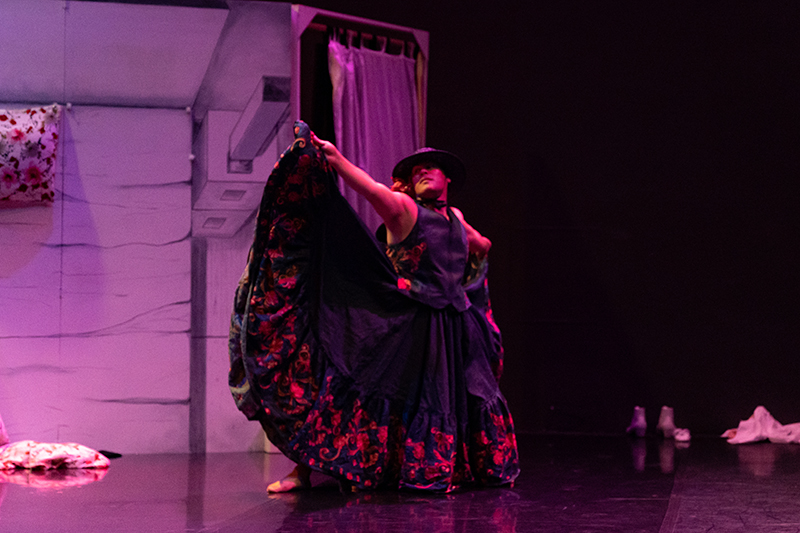
Rogelio Lopez, Photo by Ryan Kwok
~~
Joel: Firstly, I want to share how overwhelmingly moved I am by the generosity of your storytelling and the vulnerability of the work being so personal. As somebody who strives to make theatrical dances accessible, especially to communities that might not have access to contemporary performance presented in academic and/or historically privileged spaces, I feel like what you’re making is a methodically crafted, narrative driven dance theater experience that offers pathways for a diverse spectrum of the public. To be with your ideas and critical questions about what it means to be a queer Latinx immigrant requires us to bear witness to your trauma, joy, desire, and the emotional and physical labor you’ve endured being marginalized in white supremacist spaces. It’s not easy to communicate such clarity through performance, and you’ve done it well. Given what I have seen of previous works, it feels like you are emerging into a new chapter in your choreographic career. I’m excited for a lot more people to see what you’re doing.
Entre Despierto Y Dormido opens with a very personal, albeit brief, voiceover that details your time growing up poor in Santa Rosa, Mexico. It is here (during your childhood, but importantly within the context of this performance – the opening) where you offer us the beginnings of a map that illustrates the intersections of what your experience has been as a queer immigrant navigating family pressures, religion, shame and educational spaces. I don’t want to give too much away about the specifics, but you do mention emigrating to Fresno, California when you were 13, and then you jump in the narrative to your dance experience post-college. I’m curious if you can share a little bit more about what the in-between years were like for you, from 13 through college at Fresno State?
Rogelio: Yes. So, when I first moved to the US at 13, they put me in ESL… English as a second language. During that time, I was just in one class for the entire day, and what they would do is give me a crossword puzzle, and I would do a crossword puzzle, turn that in, and they would give me another one. And that was the entire day. Right before we went to lunch, all the people who spoke English came, because there was like a big sign that said “ESL,” just to call us retarded, stupid, wetback… So, I got all that hate from the very very beginning that made me feel less than. I couldn’t, I didn’t have any words. I didn’t know what I wanted to do. I wasn’t learning anything because they were not teaching me anything.
After we would do crossword puzzles, they put us in the chorus to sing, but I didn’t know the words and I didn’t know what they meant, and I wasn’t getting any feedback about what I was doing, so that was my experience in which I really wanted to just erase myself. Erase myself and at least try to assimilate. But with not knowing English and with my skin color, I wasn’t blending in at all.
It wasn’t until I went to ninth grade when my sister said, “You know, there’s a folklorico class, and they’re gonna cancel it if there’s not enough students so you have to take it.” I never danced in my life, and I’m like, I don’t wanna do that!
So, I went to the folklorico class. I not only liked it; I felt like I fit in. That’s when I started feeling like, holy smokes! My roots are important. I really, really love myself when I’m in this community. I loved it so much, and my parents loved it so much. However, the only problem with that was that it was very binary. It was a man with a woman. I have to be like, this macho kind of a thing. My parents loved that because they thought I could hide my flamboyance. They didn’t want me to be gay. But I couldn’t hide my flamboyance. I was in a closet the whole time.
Joel: Do you think this was because you were raised Catholic?
Rogelio: Yes. My family was very Catholic. We would go to church every Sunday, and at the same time we were poor. So, on the weekends, or during the weeks too when it was trash day, my dad would ask me to go with him, to go with the shopping cart, go to the trash and grab the cans and stuff. All the students that I was going to high school with would see me. That was another thing to make fun of.
Joel: That must have been so difficult. Did this impact your decision to pursue dancing in any way?
Rogelio: Yes, but folklorico was my safe place. After a couple of years practicing all hours of the day during my free time, I decided to join El Sol Dance Company my senior year of high school. We were an adult professional company and performed for parties and in theaters. I did this for three years, including during my early years in college, before I decided to focus on my school requirements.
Joel: What was that transition like for you going to college?
Rogelio: It was difficult. Because I was still an immigrant, I needed to have a green card. To get into Fresno City College, one faculty member from high school sent an application for me. It so happened that I got the call from the United States to get the green card, and I was able to go to college. I was very thankful for that teacher, but I was also very nervous because, after ESL, where they don’t teach you anything, they put you in regular English classes. That was my senior year, and that’s when the teacher had us stand up and read aloud in front of the class. That was another thing that people were making fun of because I didn’t know how to speak English, and I honestly thought that I was just so stupid.
Once I was in college I did decide to focus on dancing because I knew that I eventually wanted to teach folklorico. But at Fresno City College I had to take other classes, including modern, ballet and jazz, because they said to get a degree, I’d have to do that. Little did I know that, when I got involved, I did enjoy modern.
I graduated from Fresno City College and went to Fresno State though they didn’t have a folklorico class or a curriculum that offered folklorico. I continued with modern. From there, I went to Long Beach for my MFA. Again, there was no folklorico there either, so I continued with modern, and then it started to dawn on me that I’m going to graduate with a modern choreography degree, but even if I wanted to teach folklorico, none of those schools offer that in their curriculum.
Joel: I’m curious what it is about modern dance that offered you space to thrive, if temporarily, from some of the early trauma you had experienced growing up in Mexico as well as an early adult in high school and college? Entre Despierto y Dormido explores a range of inquiries around shame, particularly related to your sexuality, but also around being multi-lingual as well as folklorico and other Latin social dances that you weren’t able to use in your previous works, or that you could continue studying at school.
Rogelio: Modern was a very abstract form to talk about the things I’ve been living in, and I wasn’t really looking into the racism that I was experiencing. I was more dealing with… [clears voice]… Since I was eight until I was 13, I was being raped in Mexico, so I was dealing with that in all the pieces that I was creating. But it was very abstract, so people didn’t know.
Then I got a partner who was… [pauses], it was a domestic violence kind of thing… it was a relationship that was very toxic. He was 20 years older than me. We spent 14 years together in which, again, he was making me feel like I couldn’t do anything without him because my English wasn’t good. It was constant.
I was hired at Cerritos College and Loyola Marymount, making modern dances. And people liked them, so I assumed that is what people wanted. It felt superficial, very poetic, but not what I really wanted to do. I was trying to assimilate. I was trying to not listen to Mexican music, not ever speak Spanish to anyone, not do folklorico… nobody knew that I did folklorico since I was 13. I completely erased all that.
But I had these other ideas that I wanted to do…
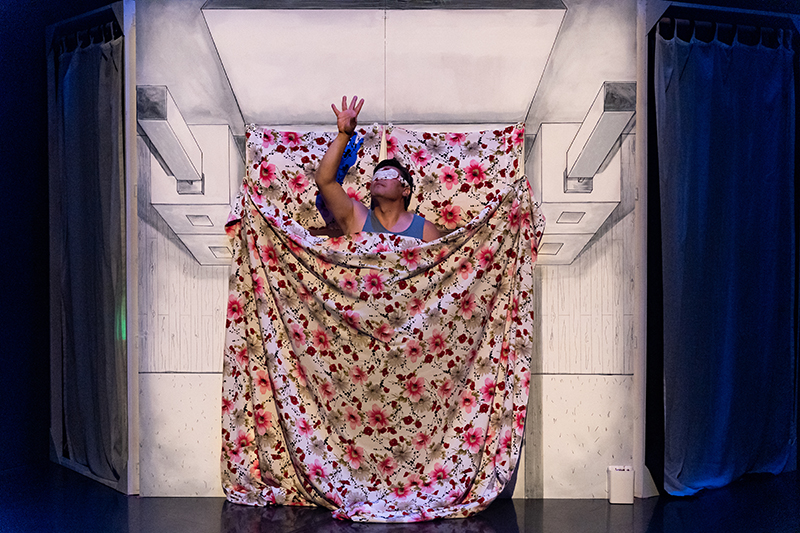
Rogelio Lopez, Photo by Ryan Kwok
~~
Rogelio and I continued our conversation, and the detailed accounts of abuse took us down a path with many meandering splinters. More than half of what we discussed centered around the racism he’s experienced since moving to the United States with his family. Much of the abuse he’s faced stems from being multi-lingual; his accent has been an inconvenience for the many white folks in power he’s worked for, whether as a student or academic. He recalled his time in the MFA program at Long Beach State, where, because of his challenges speaking and writing in English, they could not offer him TAships in his first year – which were offered to his all-white cohort. A week before he was supposed to start teaching, “…the Chair called and said, hey, you know, we’re not gonna be able to give you a class because your accent is so thick that the students will not be able to understand you, so you’re not gonna be teaching.” Instead, so that he could get paid, they offered him a position to assist the technical director of the theater, which required him to clean the floors. To make matters worse, the job required him to be at school every day at 7:00 a.m., followed by his courses. He shared with me that one of his professors noticed he was tired, so she made him stand up and walk around his desk to wake up while she continued with her lecture. Further, Rogelio was required to have five people on his thesis panel when the other cohort members were only required to have three. He was required to engage in five internships instead of one, and he was also expected to continue taking English classes even though he had already passed his efficiency exams. I asked Rogelio if there were any people of color around that were supporting him to which he responded, “No one, no one, no person of color, not one to actually talk about this with, no one to speak Spanish with. No one, nothing. There was nothing.”
These experiences of humiliation have contributed to Rogelio’s silence, to his muting, to his self-doubt, and over time the accumulative effect has taken a toll. He has experienced similar subjugation and tokenism in his current position as a faculty member at Saint Mary’s College in Moraga, CA. While much of what we talked about was off record, what he has experienced is not dissimilar to what a lot of BIPOC, queer and trans faculty face in departments where they are the only one, or part of a minority in a majority white faculty community. There is a theme of being asked to speak up and on behalf of an entire group of people, being told to tone it down, or being silenced when the fragility of white peoples’ egos dominates discussions. After making tenure, Rogelio felt he could finally speak up about the racism he’s observed on campus and in the performing arts department. However, he was quickly met with rebuke and personal insult.
While language and sexuality have been major sources of trauma in Rogelio’s life, his love and passion for dancing and teaching folklorico, too, has been a challenging hurdle to overcome. It is no surprise that folklorico was not offered at Fresno State or Cal State Long Beach, nor in the departments where he was being commissioned to set work on students during his early post-college life in Southern California. Most departments that center white/Euro forms like ballet and modern dance in their curriculums build their floors for bare feet or soft shoes. Some programs include tap or hip hop, but those techniques are usually relegated to multi-purpose rooms, gyms or theater spaces that do not have a properly sprung floor. While some departments around the country are actively de-colonizing their curriculums and spaces to decenter modern and ballet, folklorico is not a high priority. Fortunately, Rogelio’s position at Saint Mary’s includes him teaching folklorico, however he continues to be moved around to whatever space seems to be available; whether a room usually reserved for parties, or one too small to meet his pedagogical needs. He’s hoping the university will follow through on their promise to find him a dedicated space appropriate for folklorico. And while the university has praised Rogelio’s effort to increase his enrollment from five to around 50 students, as well as for creating a folklorico group, he’s spent an incredible amount of labor and energy advocating and fighting for its legitimacy. And yet, the university is actively moving resources and funding away from the performing arts in general.
The exasperation in Rogelio’s voice during our conversation was palpable. He was tired of just being seen as a body for other choreographers. He was tired of noticing how uncomfortable people were talking about his work, especially as it related to his identity and experiences as a queer Latinx immigrant. He was tired of being silenced when he spoke up. He was tired of having ideas and feeling not smart enough to make them happen. And he’s felt alone for quite a while, despite being a part of multiple dance communities. Feeling like an outsider is something he speaks of in Entre Despierto y Dormido, and that has inspired many of the scenes within it.
I asked Rogelio the process for developing the work, what he felt making it was opening for him, and if it has brought him any hope.
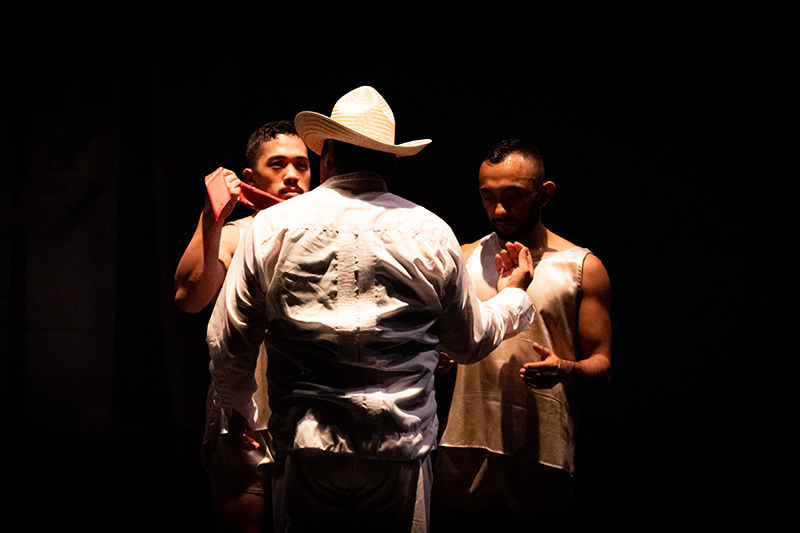
Matt Han, Rogelio Lopez, and Kevin Gaytan, Photo by Ryan Kwok
Rogelio: This piece started with anger. I was very angry, very, very angry after witnessing a dance performance in the Bay Area by two white cis male choreographers (one of whom is gay) who I felt were insensitive in the way they were trying to talk about race, and who were tokenizing the people of color in their show for effect and were making light of the BIPOC experience in general. I’m like, all these people who idolize these two choreographers come in, they think, oh my God, they’re so amazing. Wow, wow! I was feeling so alone watching it. Does anybody not see what I am seeing? Am I the only one? And I look at the audience and yeah, they’re mainly white. So, I was furious. It made me reflect on a lot of the wonderful people I’ve worked with over the years. I’ve had so many great experiences with several choreographers and I’ve learned so much. And yet, I have felt misunderstood at times. They love the way I dance. They invite me to be in their pieces. They say all these great things about me and my dancing ability, but I feel like they’ve valued my dancing more than who I am as a queer immigrant and the experiences I come with. I believe that our body carries a political weight, and they’re not taking that into consideration. My own weight is more like just a body [to them]. And in space in which they’re doing movement, they want me to do it without acknowledging who that person is being moved. And I finally said, oh my God, I don’t want to do this anymore, I can’t just be their body. I felt alone. I wanted to make a work that was about me, and I wanted it to be for other communities to see. But when I tell you that I feel stupid, it’s still there. So, this work has been something to tell me that I am smart, that I have something to say.
I spent almost two years just writing it. I had a huge script, and I kept editing it. It just came out because I was very angry. The whole thing was me just trying to tell people these things. And I was thinking, you know, that’s not gonna work. So, I worked for two years, and I kept thinking, well, I’m never gonna show it. It’s just for me. I wasn’t gonna show it. I wasn’t gonna do it. What if they don’t like it? And my partner Andrew said, “Until you start, you won’t find out, right?”
I was like…
Joel: How did you find the dancers? And what was it like having collaborators who are also queer immigrants of color?
Rogelio: To find this cast was really hard. I wanted two dancers, and I wanted both to be queer Latino immigrants. I found Kevin (Gaytan), and Kevin had his friend Matt (Han). But Matt wasn’t Latino. Some of the dancers I knew that were Latino used to do modern, and now they’re doing drag. Some of them moved, so there were not many who were able to do this. I ended up saying yes to Matt, and I’m thankful. Matt already had quit dancing, but he was doing pole dancing. Both do pole dancing, and they’re beautiful dancers. At the very beginning, I would say, “Hey, I’m thinking of exploring all these things, and it’s going to be very sexual. I wanna see if you guys are okay with that. And if not, I completely understand. I can try to find some other dancers.” They’re like, “No, sure!”
I was very transparent with them. I said, “You know, I want there to be humor. I am not a funny person. A lot of people don’t consider me funny. I’m not trying to be funny. I’m just trying to be a little bit genuine about some of the things I’ve experienced and how I am at my parents’ house.” When I was at home, I was able to yield into myself, not completely again, because of the Catholicism and because of being gay, but talking about being Latino and Mexican, I was able to just yield into my mom and just speak Spanish without even thinking about what I was gonna say or how to structure the sentence. To be able to deliberate.
To be able to talk about our experiences without explaining what it was, because we know what we have lived, has been helpful. It’s been great, and I have loved the conversations we have had.
So, my process with Kevin and Matt was very open, and we were able to have these conversations about being immigrants, about being other, about being marginalized. It was fruitful to work together and have conversations, in addition to having this safe space to create the work.
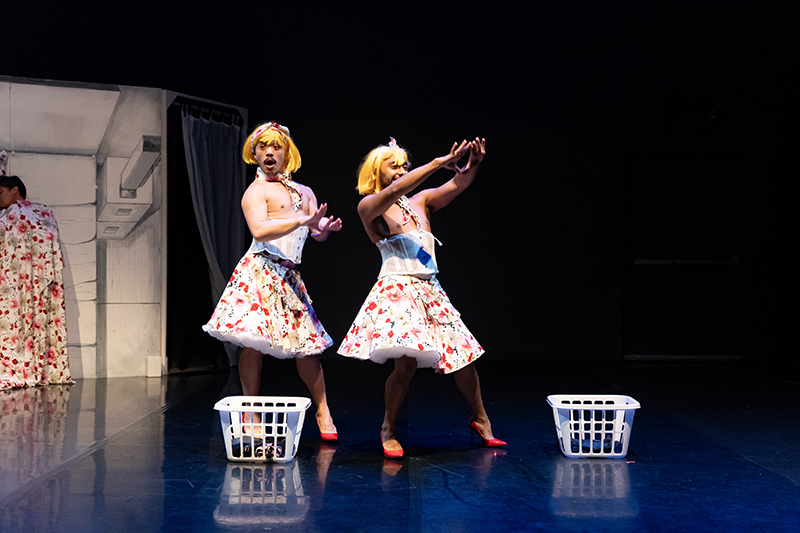
Matt Han (left) and Kevin Gaytan (right), Photo by Ryan Kwok
~~
As we continued to chat it became increasingly clear how urgent it was for Rogelio to remount Entre Despierto y Dormido, having premiered it last year. A one weekend run wasn’t enough. He knows this is a good show. He knows his story is worth sharing and speaking up about. “I do have things to say, and they might not be as smart, but they are smart for me because I love them. I’m the master of my own things and I constantly have to find ways to trick myself, to be able to think that I belong.” Rogelio shares that it’s the accumulation of these life experiences that are worth celebrating, and what he feels the work is inviting audiences to consider. “We all have different voices, and we have different ways of communicating. I wanted to give permission to other artists to do that by having conversations, and not just looking at the work.”
Despite the shame, insecurities and imposter syndrome that creep in from time to time, Rogelio has persisted. “I remember picking up trash from the trash containers and people making fun of me. I always felt it was degrading. But then when I see other people doing it, I’m thinking, like, oh my God, they’re having a hard life. They’re having a hard time. Or when I was working in the fields, it’s just everything that I have gone through, it stays, it doesn’t go away. I can’t erase it. It’s not easy to let them go.”
Perhaps selfishly, we should all be grateful Rogelio hasn’t let go. His life experiences have fueled a profoundly important work that requires us to hold a mirror to ourselves. Suspended between a tense friction of personal memories and the possibility of freedom, Entre asks us to dream with him, so that we make awaken to a new tomorrow. It’s this tension that keeps the work lively and urgent and which makes space for joy and pleasure. I feel hopeful for Rogelio, as well as for the future of queer performance. I hope that people see this new work. I hope they see Rogelio.
~~
Entre Despierto y Dormido will be performed at the Joe Goode Annex in San Francisco, CA from November 3-5 and 10-12, 2023. Tickets are available HERE. To learn more, visit www.rogeliodance.com.
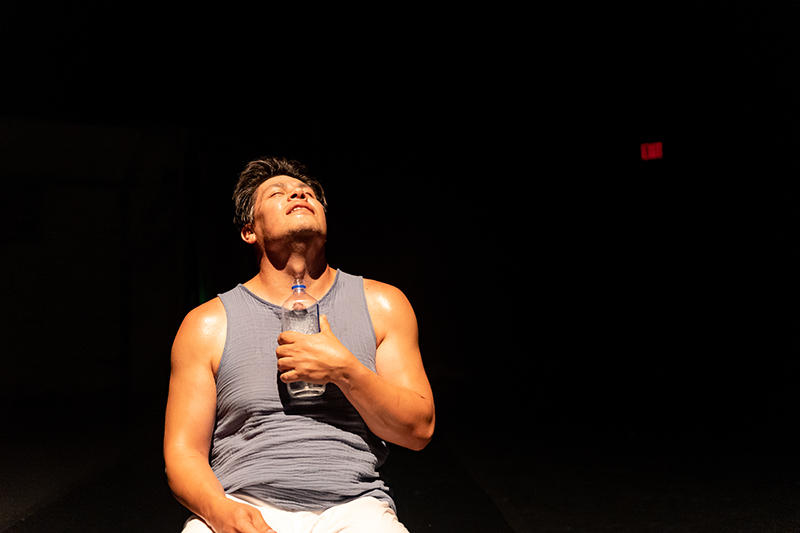
Rogelio Lopez, Photo by Ryan Kwok

One Response to “Dancing In-Between: Stories from a Queer Latinx Immigrant Artist”
What a well written piece on someone special that overcame a lot of trauma and prejudice. i hope that his life will inspire many others to follow their heart and dreams and know that there are perfect people who do care and will be there for them.
Comments are closed.